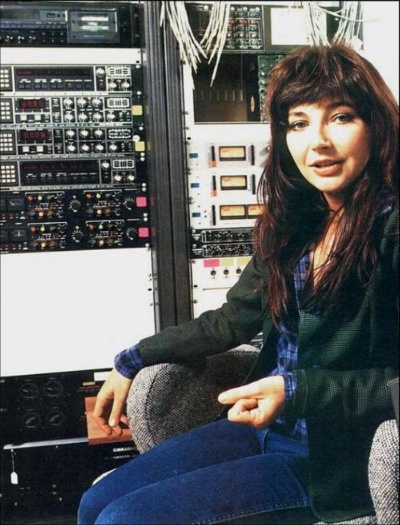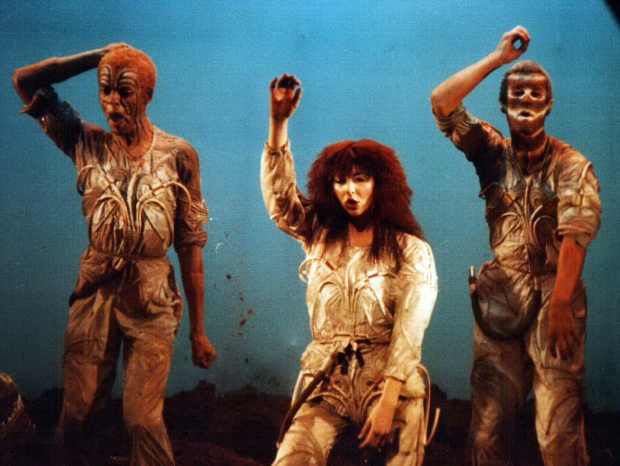Die Suche nach den Juwelen, nach dem perfekten Klang – es muss für alle eine Grenzerfahrung gewesen sein. Kate Bush entschuldigt sich fast etwas dafür bei ihren Mitstreitern: „Del Palmer engineered all the demos and every night he would sit up in the cramped little control room, getting different sounds for each track. He sat through hours of harmonies and takes of lead vocals, replying ‚I’m not bored‘
as many times as there were cups of tea, and nodding ‚Yeah, Kate, I think it sounds great!‘, a phrase to be echoed by Hugh, Haydn, Paul–Bless you all.“
Es ging in diesem langen Prozess nicht um die eigentliche Komposition, diese Phase war längst abgeschlossen. Die Arbeit bereitete die richtige Ausgestaltung [7]: „Now it’s all finished, I think of the beginning. Twenty demos, ten of which became the album. In these demos all the moods and sounds were captured, and all the way through the album these demos were referred to. Often the session would stop, we’d dig out the 1/4 inch tape of the track we were working on, and with the original flavour and sounds strong in our heads, the session would begin again. In many ways it would have been interesting to have used the demos as masters, they were so spontaneous.“
Nervenaufreibend, belastend, im Kampf mit den neuen Techniken, unter Zeitdruck, wechselnde Wegbegleiter, abhängig von äußeren Einflüssen, die Studiozeiten kosteten wahrscheinlich Unsummen – Kate Bush muss es gehasst haben. Sie äußert sich nicht dazu. Aber in logischer Konsequenz baute sie danach ihr eigenes Home-Studio auf, verwirklichte die Freiheit in der Arbeit.
 „The Dreaming“ ist ein Album, in dem die Komponistin und Sängerin ALLES will. Es ist voller Experimente, die Beherrschung des Instrumentariums und der Visionen bedeutete eine praktisch ununterbrochene Arbeitszeit, die an die Substanz ging. Die angestrebte Vision beschrieb Kate Bush so [8]: „I want it to be experimental and quite cinematic, if that doesn’t sound too arrogant. Never For Ever was slightly cinematic, so I’ll just have to go all the way.“ Rhythmen treten stärker in den Vordergrund [9]: „Since drum machines entered my life on the third album, it’s never been the same.“ Der Gesang geht weg von der vorher vorhandenen Süße und Leichtigkeit hin zu mehr Ernst, er ist tiefer und kräftiger, erdiger. Es gibt noch mehr Stimmfärbungen als früher, den Inhalten angepasst, die Stimme ist dabei immer unter völliger Kontrolle. „Es ist fast, als würde man Zeuge, wie ein Mädchen zur Frau wird.“ [2]
„The Dreaming“ ist ein Album, in dem die Komponistin und Sängerin ALLES will. Es ist voller Experimente, die Beherrschung des Instrumentariums und der Visionen bedeutete eine praktisch ununterbrochene Arbeitszeit, die an die Substanz ging. Die angestrebte Vision beschrieb Kate Bush so [8]: „I want it to be experimental and quite cinematic, if that doesn’t sound too arrogant. Never For Ever was slightly cinematic, so I’ll just have to go all the way.“ Rhythmen treten stärker in den Vordergrund [9]: „Since drum machines entered my life on the third album, it’s never been the same.“ Der Gesang geht weg von der vorher vorhandenen Süße und Leichtigkeit hin zu mehr Ernst, er ist tiefer und kräftiger, erdiger. Es gibt noch mehr Stimmfärbungen als früher, den Inhalten angepasst, die Stimme ist dabei immer unter völliger Kontrolle. „Es ist fast, als würde man Zeuge, wie ein Mädchen zur Frau wird.“ [2]
Themen des Albums sind Konflikte und Klaustrophobie, Flucht und Zerstörung, der Kampf gegen Hemmnisse und Grenzen [2]. Selbstzweifel werden in verschiedenen Songs angesprochen. Kate Bush fasst das so zusammen [3]: „I think the last album is very dark and about pain and negativity, and the way that people treat each other badly. It was a sort of cry really and I think that perhaps the biggest influence on the last album was the fact that I was producing it so I could actually do what I wanted for the first time. And then there are a lot of things we wanted to experiment with and I particulary wanted to play around with my voices, because there are a lot of different backing vocals and things like that. The different textures were important to me. I wanted to try and create pictures with the sounds by using effects.“
Auch das Einhalten einer stilistischen Grundhaltung war Kate Bush wichtig – hin zu mehr archaischen Formen, zurück zu den Wurzeln der Musik [4]: „I wanted it to be a very human, emotional album. I think we’ve come so far in making music sophisticated that we’re almost in danger of losing the roots. That’s why I think there’s been a return to tribal influences. After all, that’s where rock’n’roll came from in the first place. It’s a very ethnic album, as well, in many respects.“
Graeme Thomson fasst das alles kurz und prägnant so zusammen [2]: „Der Eindruck kaum gezügelter Hysterie in dieser Musik ist nicht allein den düsteren Inhalten der Songs zuzuschreiben, er entsteht auch aus der schieren Menge an musikalischer Information, aus einer Art klanglicher Überlastung.“
Ich teile das nur bedingt. Hysterie kommt nur in wenigen Titeln vor, klangliche Überlastung ist die Ausnahme. Die Songs sind zum großen Teil zwar reich an Informationen, an überraschenden Klangfarben, sie überfordern aber nicht (das ist vielleicht aber nur Gewöhnung). Der Kampf mit der Technik ist zu bemerken, es wird experimentiert und ausprobiert. Das klingt manchmal roh und es ist manchmal auch ein bisschen übertrieben. Kate Bush zeigt was sie kann und eine Reduktion auf das Wesentliche (die Essenz) gelingt ihr erst auf dem nächsten Album. „The Dreaming“ ist wild und ungezügelt, das ist das Schöne an ihm. Die Möglichkeiten werden ausgebreitet ohne Beschränkungen. © Achim/aHAJ
[2] Graeme Thomson: Kate Bush. Under the ivy. 2013. Bosworth Music GmbH. S. 230ff
[3] N.N.: The New Music. 3./4. August 1985.
[4] Robin Smith: Getting Down Under With Kate Bush. Unbekannte Quelle. 1982.
[7] Kate Bush: About The Dreaming. KBC article Issue 12. Oktober 1982.
[8] John Shearlaw: The Shock of the New. Record Mirror. September 1981.
[9] Kate Bush: About Hounds Of Love & Interview. KBC article Issue 17.



















Neueste Kommentare